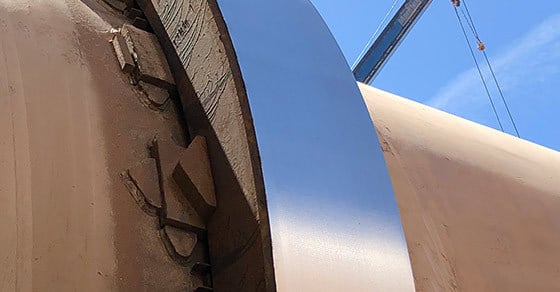Tires, or riding rings, and trunnion wheels (rollers) are the support base on which a rotary drum is mounted. As the primary point of contact and rotational movement, wear on tires or trunnions is an early indicator of an underlying issue, making identifying wear a critical aspect of maintaining a rotary drum, whether it be a dryer, cooler, kiln, or granulator.
In addition to indicating a problem, early identification of wear is paramount to preventing further damage; as the primary point of contact, wear initiated in the tires or trunnion wheels has a compound effect, propagating to other parts of the drum and exacerbating any resulting issues.
As such, identifying and addressing tire or trunnion wear as soon as possible is essential to minimizing subsequent damage and potential catastrophic failure.
Causes of Tire & Trunnion Wear
A number of different issues have the potential to cause wear on load-bearing surfaces. Some of the most common reasons for wear are summarized here.
Poor Alignment
Alignment is a key contributor to equipment performance and longevity. Rotary drums naturally fall out of alignment over time and should be routinely re-aligned to keep the unit mechanically stable.
A drum that is poorly aligned will not have an even weight distribution, and will subsequently put added stress on the unit and its many components, tires and trunnions among them.
Wear caused by misalignment is often recognizable by a groove-type pattern on the tire and trunnion wheel surfaces, as seen below.
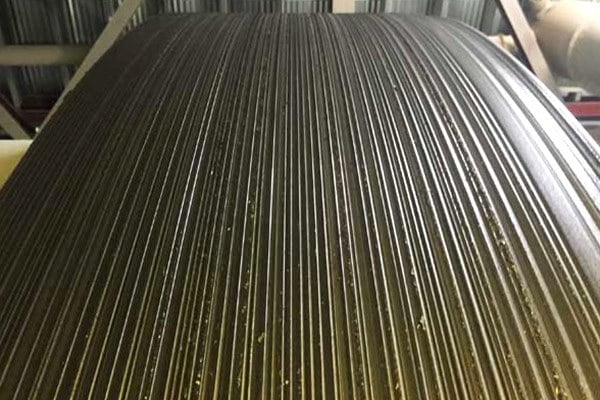
The groove-type wear pattern shown here is often an indication that the drum is out of alignment.
Excessive Wheel Skewing
Wheel skewing refers to the intentional adjustment of trunnion bearings in an effort to control axial thrust loading when a drum migrates up or downhill and comes in contact with a thrust roller. To alleviate excessive axial thrust loading, the trunnion bearings are adjusted to push or pull the drum uphill or downhill.
While this is an effective resolution, excessive wheel skewing puts too much conflicting tension on the bearings, unevenly distributing the drum load across the contact points and causing the load-bearing surfaces to wear unevenly.
Wear resulting from excessive wheel skewing is often recognizable by a mechanical spalling-type wear, as shown in the image below. Note that there is a very obvious directional quality to the wear pattern, hinting at the underlying issue.
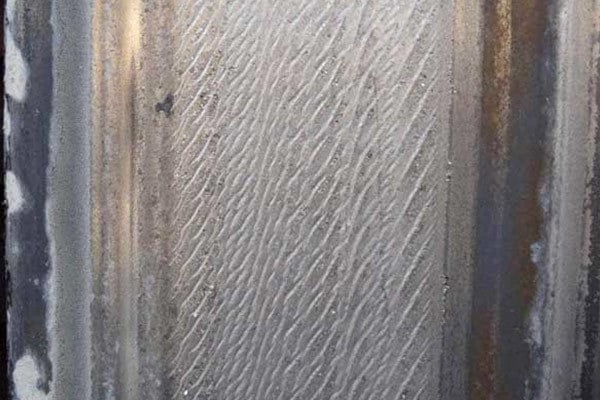
The mechanical spalling-type wear pattern shown on the tire above illustrates how excessive wheel skewing can cause a drum to ride unevenly on contact points.
Poor Housekeeping
Keeping the operational workplace clean is more than just creating a safe workspace; poor housekeeping can also cause wear on equipment. In the case of tires and trunnion rollers, fugitive material can cause excess wear in the form of abrasion, gouging, and/or corrosion on load-bearing surfaces. Similarly, tramp material in the trunnion pits may also cause severe damage to components, allowing the pinch point to act as a crusher, creating aggressive abrasion between the surfaces.
This type of wear can be exhibited in a number of different ways. One example is shown below.

The image above illustrates the wear resulting from an obstruction that has been allowed to contact the tire, causing a gouging-type wear.
Use of Oil for Lubrication
The use of oil for lubrication of wear surfaces may seem harmless, but can actually have serious consequences.
As a non-compressible fluid, oil droplets become trapped in the microfissures where the rolling contact surfaces meet. The oil cannot escape and subsequently, is driven deeper into the metal from the force of the drum, expanding these micro cracks. Over time, these fissures join together, causing pieces of metal to fracture loose, as is shown in the image below.
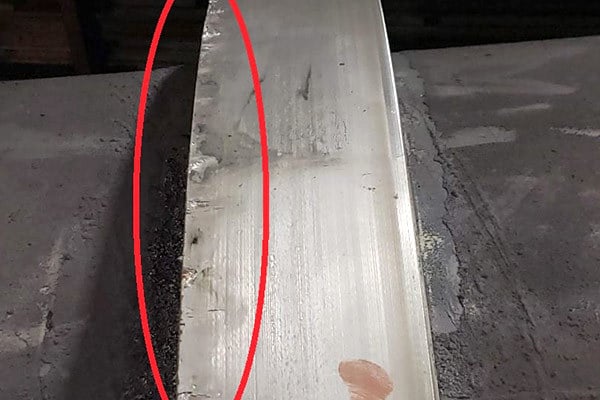
The wear pattern on the tire above shows how the use of oil for lubrication can cause cracks to form and metal to flake off.
Other Wear Patterns
While the wear patterns shown here are generally indicative of specific types of wear, not all cases of wear are as obvious and could make the underlying issue more difficult to identify. Additional types of wear include:
- Washboarding
- Spalling
- Pitting (an organge peel-like appearance)
- Rolled-over edges
- Timing marks
- Ridges
- Tapering
Wear may also be indicated by auditory cues such as chattering or vibrational sounds.
In most cases, wear on one component (the tire or trunnion) will be mirrored on the corresponding component. For example, if the tire is wearing in a convex pattern, the matching trunnion will likely have the same pattern, but will be worn concavely. However, this is not always the case; when trunnions are significantly harder than tires, only the tire may show signs of wear and require resurfacing. It’s important to know that any sign of wear, even if only exhibited on one component, should be immediately addressed to avoid further damage. An inspection should be conducted by a trained professional to determine and address the underlying cause of the wear. Depending on the severity of wear, the technician will recommend either repair or replacement.
Tire and Trunnion Wear: Repair or Replace?
Repairing tire or trunnion wheel surfaces is a cost-effective way to improve drum operation and efficiency, while also promoting longer equipment life. Repair of load-bearing surfaces is done through a procedure known as grinding.
Grinding allows the tire or trunnion to be resurfaced to like-new condition by gradually removing the damaged surface to reveal the undamaged surface beneath. This is carried out with a specialized machine and can often be conducted during production.
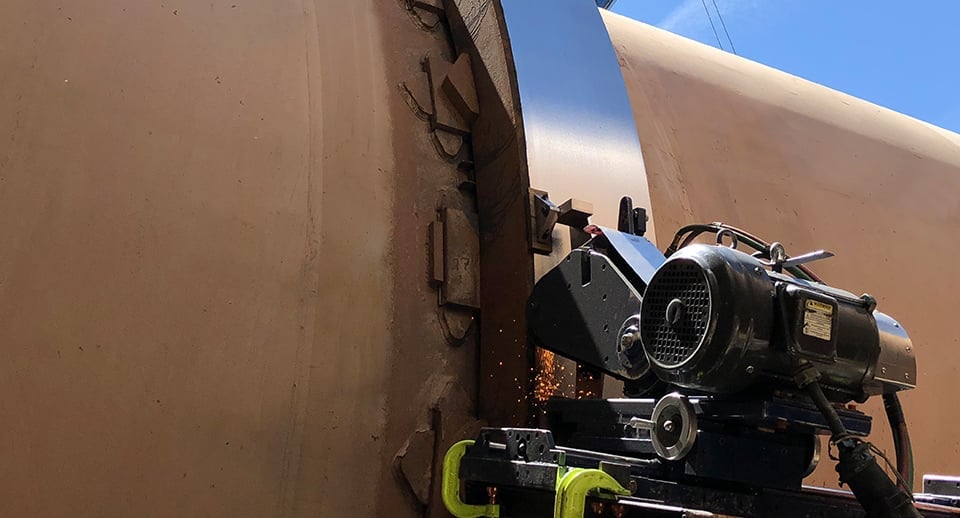
The FEECO tire grinding machine in action
Although there is no limit on how many times tires and trunnion wheels can be resurfaced, FEECO recommends replacing components when wear exceeds 10% of the original diameter.
Once wear exceeds 10%, the drum will be operating on a different slope than for which it was designed. As an important factor in the overall operational design of the drum, an altered slope can affect retention time, and ultimately, the quality of the product exiting the drum. For example, if only the discharge end wheels and tires of a rotary dryer are worn, the dryer would have a greater slope than was intended. This would subsequently decrease retention time, and potentially allow material to come out with a higher moisture content than desired.
A dryer worn on only the inlet end would have a lesser slope than intended, increasing retention time and potentially over-drying material.
Maintenance Considerations
There are two key considerations when addressing worn tires and trunnion wheels:
Qualified Work
Whether the tires and trunnions are being resurfaced or replaced, work should only be conducted by a trained technician; such procedures must be executed perfectly to achieve the careful balance required for optimal mechanical stability. Inferior work will quickly allow wear to resume.
Alignment
Any major repairs to a rotary drum, tire and trunnion wheel grinding and replacements included, will require the drum to be realigned. A drum not aligned after such maintenance will immediately begin wearing load-bearing surfaces. Laser alignment is an effective approach, offering faster and more precise results compared to traditional alignment techniques.
Conclusion
As the support base for the rotary drum, tires and trunnion wheels must be kept in good condition in order to prevent damage and potential catastrophic failure. Depending on the severity of the wear, these load-bearing surfaces may be either repaired through grinding, or replaced. In both cases, work should only be carried out by an expert.
FEECO is a leader in the manufacture and service of rotary drums. In addition to our tire and trunnion grinding and replacement services, our highly trained Customer Service Team can inspect and assess your rotary drum to identify and resolve underlying issues to prevent future damage. For more information on our parts and service support, contact us today!



